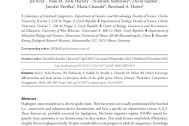Rok
2022Autoři
RNDr. František Šťáhlavský, Ph.D.doc. RNDr. Jiří Král, Dr.
Jiří Pavelka
Druhy
Pholcus alticeps Spassky, 1932Pholcus opilionoides (Schrank, 1781) ES
Pholcus phalangioides (Fuesslin, 1775) ES
Obsah
Haplogyne araneomorphs are a diverse spider clade. Their karyotypes are usually predominated by biarmed (i.e., metacentric and submetacentric) chromosomes and have a specific sex chromosome system, X1X2Y. These features are probably ancestral for haplogynes. Nucleolus organizer regions (NORs) spread frequently from autosomes to sex chromosomes in these spiders. This study focuses on pholcids (Pholcidae), a highly diverse haplogyne family. Despite considerable recent progress in pholcid cytogenetics, knowledge on many clades remains insufficient including the most species-rich pholcid genus, Pholcus Walckenaer, 1805. To characterize the karyotype differentiation of Pholcus in Europe, we compared karyotypes, sex chromosomes, NORs, and male meiosis of seven species [Pholcus alticeps Spassky, 1932
P. creticus Senglet, 1971
P. dentatus Wunderlich, 1995
P. fuerteventurensis Wunderlich, 1992
Pholcus phalangioides (Fuesslin, 1775)
Pholcus opilionoides (Schrank, 1781)
P. silvai Wunderlich, 1995] representing the dominant species groups in this region. The species studied show several features ancestral for Pholcus, namely the 2n♂ = 25, the X1X2Y system, and a karyotype predominated by biarmed chromosomes. Most taxa have a large acrocentric NOR-bearing pair, which evolved from a biarmed pair by a pericentric inversion. In some lineages, the acrocentric pair reverted to biarmed. Closely related species often differ in the morphology of some chromosome pairs, probably resulting from pericentric inversions and/or translocations. Such rearrangements have been implicated in the formation of reproductive barriers. While the X1 and Y chromosomes retain their ancestral metacentric morphology, the X2 chromosome shows a derived (acrocentric or subtelocentric) morphology. Pairing of this element is usually modified during male meiosis. NOR patterns are very diverse. The ancestral karyotype of Pholcus contained five or six terminal NORs including three X chromosome-linked loci. The number of NORs has been frequently reduced during evolution. In the Macaronesian clade, there is only a single NOR-bearing pair. Sex chromosome-linked NORs are lost in Madeiran species and in P. creticus. Our study revealed two cytotypes in the synanthropic species Pholcus phalangioides (Madeiran and Czech), which differ by their NOR pattern and chromosome morphology. In the Czech cytotype, the large acrocentric pair was transformed into a biarmed pair by pericentric inversion.



